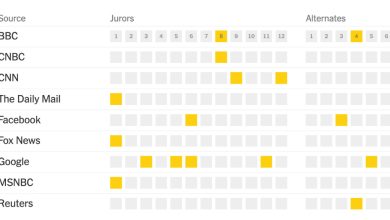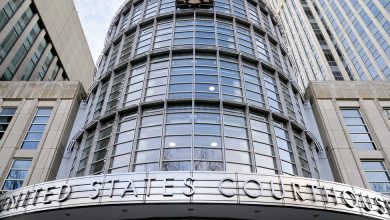Are Google and Meta to Blame for the Racist Massacre in Buffalo?

Ask the families of the victims of last year’s racist massacre in Buffalo what they want and one goal comes up again and again.
“To hold anybody and everybody, in anything and everything, that had a part in what happened to my mother and the other nine, what was done in Buffalo, to hold them accountable,” said Garnell W. Whitfield Jr., whose mother, Ruth, was one of 10 people — all of them Black — who were killed.
That longing for accountability has resulted in two new civil lawsuits filed by the Buffalo families, the most recent attempt to hold social media companies responsible when men steeped in violent ideologies on those platforms open fire. But even as such massacres continue, seemingly unabated, lawsuit after lawsuit against tech giants has thus far failed to award victims and their families in court.
Indeed, the Buffalo suits will face significant challenges, experts in digital law say, with some blunt predictions as to their likelihood for success.
“It’s not going to work,” said Eric Goldman, a professor at Santa Clara University’s law school and a co-director of its High Tech Law Institute.
In recent years, a handful of cases involving social media and tragic incidents have advanced past preliminary stages, including two lawsuits brought by families of victims of terrorist attacks in Istanbul and Paris that reached the Supreme Court. But the nation’s highest court rebuffed both efforts to hold companies, including Google and Twitter, liable for Islamic State videos appearing on their sites.
The primary legal obstacle, Mr. Goldman and others say, remains Section 230 of the Communications Decency Act of 1996, which provides protection to online companies from liability from third-party content published on their sites. Drafted in the incipient days of the internet, the statute was meant to protect internet companies from lawsuits over speech published in chat rooms or other forums.
But as the decades have passed, critics say, its scope has broadened, even as calls to narrow it have grown..
“The vast majority of courts have really indulged this very excessive, unqualified immunity approach to the reading of Section 230,” said Mary Anne Franks, a law professor at the University of Miami who has advocated reforms to Section 230. “There hasn’t been a case, I think, exactly like this one. But if you look at some of the other attempts to hold social media companies accountable for acts of terrorism, et cetera, they’ve mostly lost.”
All of which galls people like Barbara Massey-Mapps, whose sister, Katherine, was also murdered in the Buffalo attack, during which the gunman used an assault rifle to shoot 13 customers and employees of a Tops supermarket. Three people survived.
The gunman, Payton Gendron, an avowed white supremacist, livestreamed his attack. He had written voluminous online diaries filled with racist content and references to so-called “replacement theory,” which posits a nefarious conspiracy to replace white people with people of color.
And Ms. Massey-Mapps, 66, believes that social media is to blame for introducing him and others to such ideas, and for using algorithms that are capable of feeding a steady stream of videos to people seeking racist or other hateful content.
“This wouldn’t spread as fast if you didn’t have Facebook or YouTube or what have you,” she said. “There’s so much negativity, so much ugliness. And I’m like, Why?”
Ms. Massey-Mapps was among three victims’ families and an employee of Tops who filed suit in May against social media companies, including Meta (which owns Facebook and Instagram) and Google (which owns YouTube). A second suit was filed this month by a legal team led by Benjamin Crump, a prominent civil rights attorney who said he intended to use the gunman’s own admission that he was influenced by social media to prove the case and set a new precedent.
“The laws, the technical justifications, always exist until they don’t exist anymore,” Mr. Crump said, “Until people say, We can’t condone this.”
For opponents of Section 230, there have been glimmers of hope: In 2021, a decision by the U.S. Court of Appeals for the Ninth Circuit in San Francisco — Lemmon v. Snap — limited the immunity provided by the law, in a case involving a so-called “speed filter” on Snapchat, which encouraged speeding in cars and had led to the deaths of three teenagers using the filter.
A recent case in Oregon — against the anonymous chat site Omegle, which has been used by some sexual predators — has also overcome Section 230 challenges. It is in the discovery phase and is headed to trial, the plaintiffs’ attorneys said.
Like those cases, the suits filed in Buffalo argue that the social media platforms in question are essentially dangerous products, an effort to sidestep the content protections provided by Section 230. The two suits — filed in state court in Erie County — use nearly identical language, referring to the apps as “defective” and suggesting they were designed to be addictive to users and to encourage violence.
The Supreme Court, however, dealt blows to opponents of Section 230 in May, when it ruled against plaintiffs in the two suits brought by families of victims of terrorist attacks seeking damages from Google and Twitter.
Jess Miers, legal advocacy counsel for Chamber of Progress, a lobbying group that represents tech firms such as Google and Meta, said that those Supreme Court decisions reinforced the protections provided by Section 230, while allowing websites leeway to crack down on hateful posts.
While “these tools and algorithms inadvertently amplify objectionable content,” she added, the Section 230 protections are “crucial to ensure that social media companies can continue using algorithms” to monitor and minimize “harmful content.”
Jeff Kosseff, an associate professor at the U.S. Naval Academy’s Cyber Science Department, said that the Buffalo suits could face additional challenges over free speech, as hate speech was constitutionally protected, with the exception of “true threat or imminent incitement of violence.”
In recent years, there has been increased attention on the effects of social media on young people — including a warning from the surgeon general in May. And Mr. Kosseff says such anti-tech sentiments could begin to suffuse legal arguments.
“We’ve had a lot of judges, particularly in cases against big tech companies, who are not very big fans of big tech companies,” Mr. Kosseff said. “So that’s why I would never say it’s absolutely doomed.”
Mr. Gendron, now 20, has already faced criminal charges: In February, he pleaded guilty in state court and was sentenced to life in prison without the chance of parole. He also faces federal charges, including hate crimes, some of which could carry the death penalty.
At a news conference to announce the second lawsuit, family member after family member stepped up to the podium, some in tears, others stoic, to describe their pain.
“It doesn’t turn off for me,” said Kimberly Salter, whose husband, Aaron, a retired Buffalo police officer, was killed while working as a security guard at Tops and hailed as a hero afterward. “I’m sure it doesn’t turn off for the other families either.”




